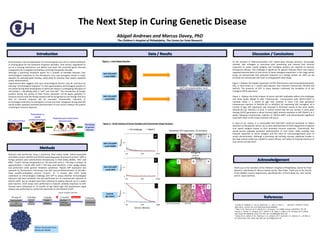
IUGT Poster - Abby Andrews
- 1. DilutionDilution AAV 2/8.eGFP Lamb #2003 Abigail Andrews and Marcus Davey, PhD The Children’s Hospital of Philadelphia, The Center for Fetal Research IntroductionIntroduction The Next Step in Curing Genetic Disease Data / ResultsData / Results ReferencesReferences AcknowledgementAcknowledgement Gene therapy is the transplantation of corrected genes into cells to replace defective or missing genes for the treatment of genetic disorders. Viral vectors, engineered to act as a carrying mechanism, can deliver and insert the corrected genes (termed transgenes) into a targeted cell thereby correcting the genetic disorder. Although a promising treatment option for a number of heritable diseases, host immunological responses to the therapeutic virus and transgene remain a major obstacle for postnatal gene therapy, particularly for diseases that require repeated vector administration1 . Experimental data suggests that such immunological barriers may be overcome by inducing “immunological tolerance” to viral capsid proteins and transgene product in the period during fetal development in which the thymus is undergoing education of self proteins – identifying what is “self” and “non-self”.2 The introduction of foreign proteins during this period of fetal thymic education (14-18 weeks gestation in humans) ensures that the foreign proteins will be recognized as non-foreign and thus that no humoral response will be mounted. Theoretically, induction of immunological tolerance to therapeutic viruses and their transgenes during fetal life would enable repeated postnatal administration of viral vectors without the patient mounting an immune response. Thank you to the members of the Children’s Hospital of Philadelphia, Center for Fetal Research, specifically Dr. Marcus Davey and Dr. Alan Flake. Thank you to the faculty of the Baldwin Science Department, specifically Mrs. Christie Reed, Mr. Nick Vechik, and Dr. Susan Dorfman. As the promise of Adeno-associated viral -based gene therapy becomes increasingly realized, safe strategies to overcome both preexisting and induced host immune responses to vector capsid antigens and transgene product are required to improve therapeutic efficacy. This challenge is significant for genetic diseases which may require repeated administration of viral vector to boost transgene expression. In this large animal study, we demonstrate that postnatal tolerance to a foreign protein (ie. GFP) can be achieved via intravascular AAV-IUGT to mid-gestation fetal sheep. Figure 1 displays the hepatic expression of GFP (fluorescence and immunohistochemisty; IHC) in fetal lambs at 1 month post-injection that received intravascular AAV2/8 and AAV2/6. The presence of GFP in these biopsies confirmed the durability of of the transgene (GFP) expression. Figure 2 displays the ELISA analysis of serum anti-GFP antibodies before (Pre-challenge) and three weeks (Week 3) after intramuscular immunization with AAV2/1.eGFP in neonatal lambs (~ 1 month of age) that received in utero (~65 days gestation) intravascular injection of AAV2/8 (A) or AAV2/6.2 (E) expressing GFP transgene. At 6 months of age, GFP expression was assessed in hind-limb muscle of the same lambs; AAV2/8 (B,C,D), AAV2/6.2 (F,G,H). A control animal that did not receive in utero gene therapy (IUGT) generated a robust humoral (IgG) immune response to GFP (Panel I) at 3 weeks following intramuscular injection of AAV2/1.eGFP, and demonstrated significant neutrophil influx at the muscle injection site (J,K,L). In view of our results, it is conceivable that AAV-IUGT could be harnessed to induce tolerance to therapeutic vectors via in utero administration of AAVs engineered to express viral capsid antigens known to illicit postnatal immune responses. Theoretically, this would permit repeated postnatal administration of viral vector while avoiding host immune responses to vector antigens and the need for immunosuppression prior to vector administration. Although a promising and exciting concept, additional studies in the large animal model are needed to assess efficacy and safety of inducing tolerance to viral vectors via AAV-IUGT. MethodsMethods Research was performed using a preclinical, fetal sheep model. Adeno-associated viral (AAV) vectors AAV2/8 and AAV2/6 expressing green fluorescent protein3 (GFP; a foreign protein) were administered intravenously to fetal sheep (#2003, “Wiz” and #465, “Cupid”) during mid-gestation at ~65 days (full term is ~150 days in sheep). At approximately 1 month after birth (~110 days post-injection), a liver wedge biopsy was performed under general inhalation anesthesia. Hepatic GFP expression was assessed by fluorescence microscopy and GFP immunohistochemistry of formalin- fixed, paraffin-embedded sections (3-5µm)4 . At ~2 months after birth, lambs underwent an immunological challenge with GFP to assess whether immunological tolerance had been achieved; this was performed via an intramuscular injection of AAV2/1.eGFP. Serum samples were then collected at weekly intervals up to 5 weeks post-injection. ELISA assays were performed to measure antibody responses to GFP. Animals were euthanized at ~6 months of age (adult age) and postmortem organ analysis was performed to confirm the expression or lack thereof of GFP. Discussion / ConclusionsDiscussion / Conclusions Pre-immune Fetus Tolerization to capsid proteins/transgen es Repeated post-natal vector administration Transgene Expression Correction of genetic disorder ~ 65 days IV ~150 days AAV2/8.eGFP & AAV2/6.2.eGFP Birth ~4 weeks Liver Biopsy ~2 months Immune Challenge AAV2/1.eGFP Serum samples collected ~6 Months Euthanasia Figure 1 - Liver Biopsy Results: AAV 2/8.eGFP Lamb #2003 (GFP-immunoperoxidase, 4um) AAV 2/6.eGFP Lamb #465 (3.22x10^12 gc) (1.66x10^11 gc) Figure 2 – ELISA Analysis of Serum Samples and Postmortem Organ Analysis AAV 2/6.eGFP Lamb #465 1 Amado, D., Mingozzi, F., Hui, D., Bennicelli, J. L., Wei, Z., Chen, Y., . . . Bennett, J. (2010) Sci Transl Med, 2(21), 21ra16. doi: 10.1126/scitranslmed.3000659 2 Flake, A. W., Harrison, M. R., Adzick, N. S., & Zanjani, E. D. (1986) Science, 233(4765), 776-778 3 Joyeux, L., Danzer, E., Limberis, M. P., Zoltick, P. W., Radu, A., Flake, A. W., & Davey, M. G. (2014) Hum Gene Ther Methods, 25(3), 197-205. doi: 10.1089/hgtb.2013.143 4 Davey, M. G., Zoltick, P. W., Todorow, C. A., Limberis, M. P., Ruchelli, E. D., Hedrick, H. L., & Flake, A. W. (2012) Gene Ther, 19(2), 201-209. doi: 10.1038/gt.2011.83 Adeno-Associated Virus Molecular Model Control (No IUGT)